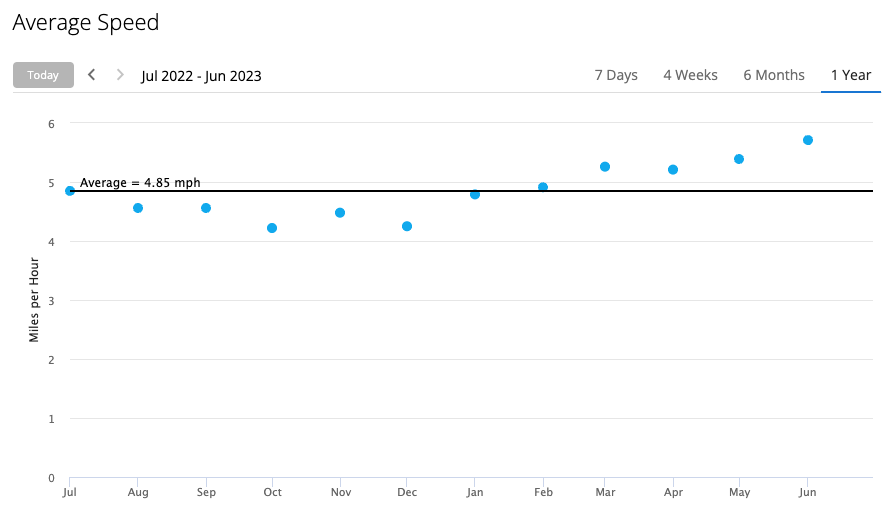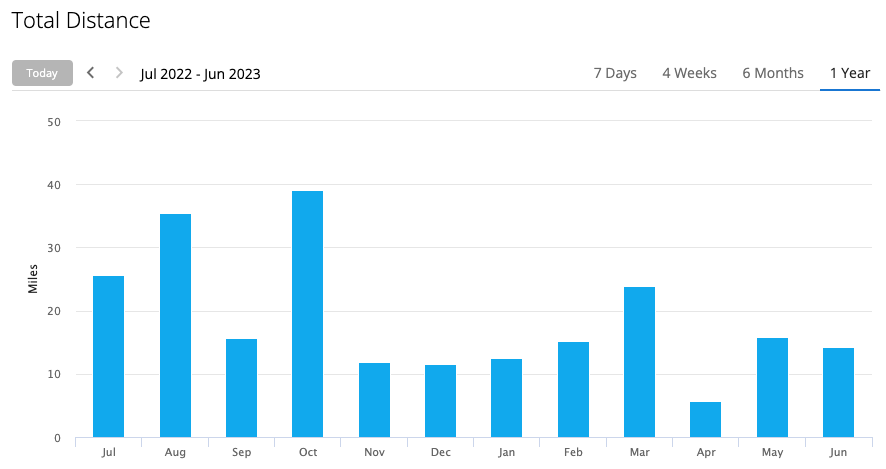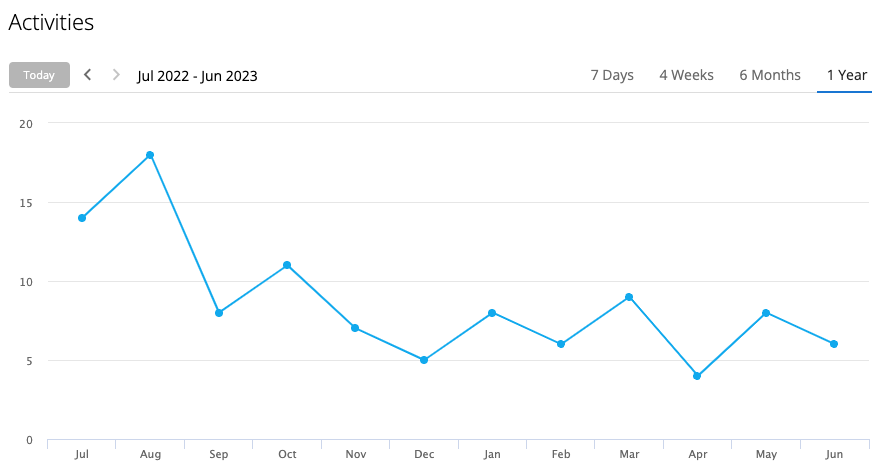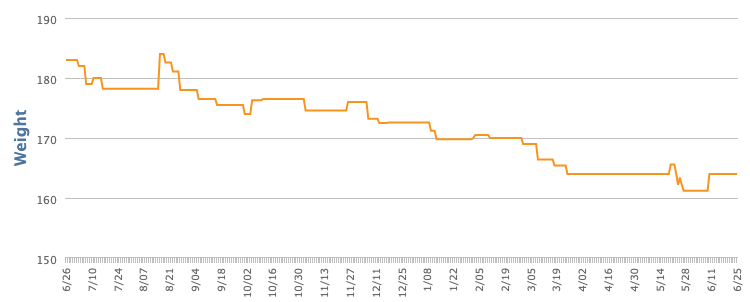One Year of Running
Published 2023-06-24
I started wearing the Garmin Forerunner 255 on July 9th 2022, and have worn it almost all day and every day since then. Around late May of 2022, I started going to the gym and running at least twice a week, although I have been running sporadically since 2021. Since I'm past the one-year mark of more focused training and almost at the one-year mark on performance data, I think it's time for a retrospective to see how I've done.
Most of my running performance before this past year pretty much matched the earlier runs I did before tracking. I've never been a runner and have never run more than one mile at a time. In high school, my one-mile time was just under 12 minutes (that was the only time I actually ran one mile). Despite that, if there's one takeaway from this write-up, it's that progress is slow, but it's no doubt happening!
Then vs Now
The two comparisons below have two before and after runs with good performance (neither PR setting nor below average) and are representative of the time they happened. The two runs in each comparison are similar in enough ways that they can be compared.
Comparison 1
Comparison 1 is between two different runs that had roughly the same time, ascent total, and ballpark temperature. Although they were different paths (with different incline changes), it's still a decent performance comparison.
The below graph is from a run on August 6, 2022. It was a 2.24-miler which I ran in 28:37 (which is an average pace of 12:47/mi). Total ascent was 157 ft, and the temperature on that day was 86F.

The below graph is from a run on June 7, 2023. It was a 2.72-miler which I ran in 28:48 (which is an average pace of 10:36/mi). Total ascent was 164 ft, and the temperature was 82F.

Comparison 2
Comparison 2 is run on mostly the same path (although there are some small differences at the end).
The below graph is from a run on November 21, 2022. It was a 1.61-miler which I ran in 20:26 (which is an average pace of 12:26/mi). Total ascent was 157 ft, and the temperature was 46F.

The below graph is from a run on June 25, 2023. It was a 1.53-miler, which I ran in 15:55 (which is an average pace of 10:26/mi). Total ascent was 164 ft, and the temperature was 93F.

Takeaways
Average pace is down by about 2 minutes for roughly equivalent runs! Most runs in July and August of 2022 are at an average pace greater than 12 minutes per mile, with the worst going up to 14+ minutes per mile. The worst ones were typically on hotter days where I walked most of the time; the best ones (rarely sub-12 minutes per mile) were on the treadmill. Runs in May and June of 2023 are at an average pace of roughly 10–11 minutes per mile, despite the high temperatures.
Heart rate is steadier, plateauing at 180 at a nominal 10 min/mi pace unless there is an incline! Although this behavior was somewhat present before, the heart rate plateau is much flatter now.
Less pace volatility, more pace control, especially with incline changes! The most subtle difference between the runs is that there's a lot less variance in moment-to-moment pace. The pace trends tend to be the same -- go slower on an incline and faster on a decline. But the pace adjustment while running is smooth, even when fatigued or on a difficult slope.
Running for longer times and distances with better heat endurance! Walking is only needed on inclines where heart rate pushes past 190; otherwise, long and steady runs are now possible and getting easier.
Major Milestones
5k milestones:
- On February 15th 2023, I ran a 5k continuous (no walking) for the first time. Time was 36:24 for this treadmill run, with a max HR of 200 and a plateau/median HR of 187.
- On February 19th 2023, I ran my first ranked 5k (Austin Marathon 5k #31659). Time was 31:54 for this outdoor run, with a max HR of 199 and a plateau/median HR of 191. Temperature was 50F.
- On June 10th 2023, I ran a sub-30 minute 5k for the first time. Time was 29:58 for this treadmill run, with a max of 190 and plateau/median HR of 183. Best Distance Times as of June 25 2023:
- 1km - 5:04 min
- 1mi - 8:21 min
- 5k - 29:58 min
Other noteworthy events:
- In October 2022, I ran and walked about 20 miles in a 48-hour period for the Ragnar Relay. I didn't hit any PRs on time, but that was the longest run in a short period of time. The last time I moved this distance was during a walking-only hike. The relay runs/hikes were done in four sections through the 48-hour event, and during the last section, my minimum heart rate was 150 and my maximum was 180, despite walking about 50% of it.
- In April 2023, during a trip to Yosemite, I hit a hiking personal record for the largest continuous ascent (without stopping) of 1,500ft over a roughly 1-hour period. It's a good example of how running improves leg fitness. Ascent heart rate peaked at 197 but was generally between 170-190.
Monthly Trends
Average Speed

Total Distance

Activity Count

Takeaways
Longer distances per run improved endurance despite less total distance. Early runs were 1-2 miles on alternating days. More recent runs are once or twice weekly 2-3 milers. With the reduced training volume from September to January, I also slowed down my running speed to as low as 15 minutes per mile to slowly reduce the amount of walking time during a run.
Physical & Mental Changes
Legs
I used to get pain in the calves fairly often, especially toward the end of the day. I suspect the cause was related to diet and exercise. High exertion with insufficient food seemed to be the cause (no strong evidence, just intuition). In the past few months, I haven't had a single instance of this pain.
I used to run in response to fatigue in the legs due to a lack of movement. Obviously, with the increase in movement, that hasn't happened since.
I've noticed substantially more developed muscles in the calves and thighs. They look and feel toned.
When I started running, I would consistently get pain in my right knee. I still have that pain, but it has lessened. It used to be something that I would have to power through during the run for several minutes. Now, it usually passes in the first couple of steps, if it's even there at all.
Heart & Lungs
Back in July 2022, I would very quickly get flushed -- roughly 5-6 minutes into the run. I would be fatigued nearly immediately after the run, often needing a nap. And I would breathe heavily (1 step = 1 breath) even at a relatively slow pace. In June 2023, I have not gotten flushed, even on longer runs. I rarely have post-run fatigue, and when it does happen, it's usually a signal of an inadequate diet rather than exertion. And my breathing is deeply controlled on a four-step in and four-step out cadence with adjustments based on incline and pace.
Side Stitch & Shoulder Pain
I've had side stitch, or exercise-related transient abdominal pain (ETAP) and shoulder pain. It almost always happens if my heart rate exceeds 190 for a long period of time (like on an incline). There isn't a known resolution for this, but since it does seem correlated to heart rate, it is likely related to the intensity that is at least beyond the aerobic threshold and perhaps at the upper bound of what my body can handle. Some studies report that the cause is a lack of adequate oxygen for that level of exertion.
Mental Stamina
By "embracing the suck", my tolerance for monotony has improved. I find myself able to handle longer runs on the treadmill, despite the boredom. Still, for treadmill runs, I find myself having to engineer ways to be distracted. Sometimes it's music, sometimes TV shows, sometimes monotonous counting of breaths, and sometimes a reminder of hitting a new PR or target. Outdoor runs tend to be more enjoyable despite the strain of elevation changes and summer heat.
Diet, Exercise, and Weight
For most of the year, I've been slowly cutting weight towards reaching a target weight of 150 lbs (to reach a "normal" body fat percentage target). I didn't strictly adhere to a diet besides counting calories (although I did not strongly count macros). I started at roughly 185 lbs and am now at 165 lbs. The weight loss happened in bursts, mostly due to changes in diet (not exercise). I've also aggressively cut sugar and reduced healthy fats (butter, ghee, fried foods, etc). Although there have been several "cheat" days which have been the cause of most breaks in weight loss as the diet adherence momentum is lost.

One consequence of this cutting phase seems to be the loss of some muscle mass in my arms, which led to increased wrist and arm pain. Since the start of June, I've started weightlifting to support muscle development in the arms. Although I'm still attempting to maintain a caloric deficit. More realistically, I'll hit a caloric break-even due to weak adherence to the calorie count.
Running performance hasn't seemed to have any impact here except for additional calorie burn. Muscle development on the leg has been good, so there seems to be little to no impact so far with the caloric deficit diet.
Equipment
Shoes
I have the Brooks Men's Ghost 14. They're really good shoes.
Smartwatch
I have the Garmin Forerunner 255. It works pretty well; most of the data collected and presented in this write-up is from passive data collection by the watch. The only active data entry is the weight.
Early treadmill runs were very off (+-30%+) and hard to calibrate. Even now, treadmill runs tend to be skewed (+5%). Marathon and performance conditioning estimates are aggressive (probably beyond what I can do right now). But the workout report and training status feedback are typically good and reflect many of the findings in this write-up.
Hydration
I have water bottles, a 2-liter hydration backpack, and a hydration belt. Water bottles are ideal for the gym. The hydration backpack is intended for long outdoor runs, but I find it bulky and inconvenient because it shifts around a lot (despite several attachment points to the body). The hydration belt also shifts around a lot, and I've already lost one water bottle (within 48 hours of purchasing it). Although the pouch on the belt and the backpack storage space are good for hiking or other outdoor activities, I still need to find a good solution for hydration while running outdoors, where what you bring with you is what you have to drink.
Amino acid, caffeine, and electrolyte drink supplementation immediately before running seems to improve performance. I have no strong evidence for this, just intuition. Although it does seem to offset post-run fatigue caused by dehydration, especially on hot outdoor runs where I sweat a lot.
Other Notes
Improvement comes in waves and is not continuous. There are occasional several-day or even several-week periods of low or no-effort runs. During these periods, I often stop eating properly (worse than lacking diet adherence) and my energy is wildly lower. A mix of planning like meal prep, enforcing some control over my environment (like keeping sugar out), and peer pressure all support kicking me out of the slump. But this ultimately has to do with motivation and the willingness to stick to the plan. What really gets me back on the wave of improvement is that intrinsic motivation -- the reminder of reward and consequence. The amazement at looking back at the new muscle development, the self-disgust with how much sugary greasy junk I've eaten, and the reminder of what I will look and feel like when I both go back to the good lifestyle and eventually reach my goals all converge. Those thoughts lead to actions. And those actions stay for a while, usually until I get distracted.
Heat training during the summer may support better winter performance. It's too early to see what the effect of outdoor summer runs will be, but the performance loss hasn't been as severe as expected. No PRs have been hit during the summer (off the treadmill), but it's possible.
Goals for the next 12 months
- Run a 10k in 50 minutes -- that is a roughly 8 minute per mile pace for 6.21 miles. At the current projected rate of improvement, a 5k at an 8 minute per mile pace is expected, so this is a substantially more difficult task.
- Run a marathon (42 km) in 6.5 hours -- that is a 15 minute per mile pace for 26.2 mi.
- Figure out how to constantly self-correct my actions to stay on track.
How to get there
- Heat acclimation training for increasing mental stamina and physical endurance.
- Run longer distances (10k+) at slow paces. Twice per month.
- Build up to the marathon distance (42 km). Once per month.